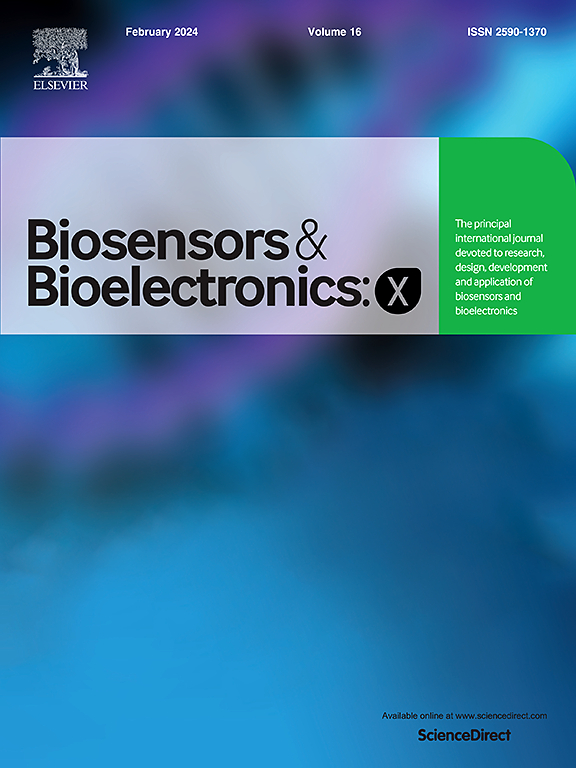Optimization of a portable ligand-free optical spectroscopy method for SARS-CoV-2 protein detection
IF 10.61
Q3 Biochemistry, Genetics and Molecular Biology
引用次数: 0
Abstract
The rapid spread of COVID-19 has underscored the need for fast, portable, and reliable diagnostic tools. Conventional techniques such as polymerase chain reaction and emerging biosensors like surface plasmon resonance require complex procedures for ligand development and immobilization, which often involve probes, antibodies, or aptamers. This study proposes a ligand-free detection strategy based on optical spectroscopy for the rapid identification of the SARS-CoV-2 protein. The detection workflow includes two key phases: optimization and clinical validation. In the optimization phase, transmittance spectral measurements were conducted on SARS-CoV-2 protein to determine the optimal wavelength within the ultraviolet–visible–near infrared range (200–1100 nm). The most effective fiber configuration was also evaluated using three combinations of transmitter–receiver fiber diameters: 600–400 μm, 600–100 μm, and 200–400 μm. The optimal detection parameters were identified as 275 nm for wavelength and 600–400 μm for fiber configuration. Specificity testing confirmed complete discrimination between SARS-CoV-2 protein and other proteins, including SARS-CoV and rBmSXP, with 100 % specificity. Subsequently, clinical validation was conducted on 21 patients using the optimized parameters. Optical spectroscopy measurements were compared with real-time quantitative reverse transcription polymerase chain reaction (RT-qPCR), yielding a correlation coefficient of 0.6038 with statistical significance (p < 0.01). These findings demonstrate the potential of portable, ligand-free optical spectroscopy for rapid SARS-CoV-2 detection at the point of care.
便携式无配体光学光谱法检测SARS-CoV-2蛋白的优化
COVID-19的迅速蔓延凸显了对快速、便携和可靠诊断工具的需求。传统的技术,如聚合酶链反应和新兴的生物传感器,如表面等离子体共振,需要复杂的配体开发和固定程序,通常涉及探针,抗体或适体。本研究提出了一种基于光谱学的无配体检测策略,用于快速鉴定SARS-CoV-2蛋白。检测工作流程包括两个关键阶段:优化和临床验证。在优化阶段,对SARS-CoV-2蛋白进行透光光谱测量,确定其在紫外-可见-近红外(200-1100 nm)范围内的最佳波长。通过收发光纤直径的三种组合:600-400 μm、600-100 μm和200-400 μm,对最有效的光纤配置进行了评估。最佳检测参数为波长为275 nm,光纤结构为600 ~ 400 μm。特异性检测证实SARS-CoV-2蛋白与其他蛋白(包括SARS-CoV和rBmSXP)完全区分,特异性为100%。随后,采用优化后的参数对21例患者进行临床验证。光谱学测量值与实时定量逆转录聚合酶链反应(RT-qPCR)进行比较,相关系数为0.6038,具有统计学意义(p <;0.01)。这些发现证明了便携式、无配体光学光谱技术在护理点快速检测SARS-CoV-2的潜力。
本文章由计算机程序翻译,如有差异,请以英文原文为准。
求助全文
约1分钟内获得全文
求助全文
来源期刊

Biosensors and Bioelectronics: X
Biochemistry, Genetics and Molecular Biology-Biophysics
CiteScore
4.60
自引率
0.00%
发文量
166
审稿时长
54 days
期刊介绍:
Biosensors and Bioelectronics: X, an open-access companion journal of Biosensors and Bioelectronics, boasts a 2020 Impact Factor of 10.61 (Journal Citation Reports, Clarivate Analytics 2021). Offering authors the opportunity to share their innovative work freely and globally, Biosensors and Bioelectronics: X aims to be a timely and permanent source of information. The journal publishes original research papers, review articles, communications, editorial highlights, perspectives, opinions, and commentaries at the intersection of technological advancements and high-impact applications. Manuscripts submitted to Biosensors and Bioelectronics: X are assessed based on originality and innovation in technology development or applications, aligning with the journal's goal to cater to a broad audience interested in this dynamic field.
 求助内容:
求助内容: 应助结果提醒方式:
应助结果提醒方式:


